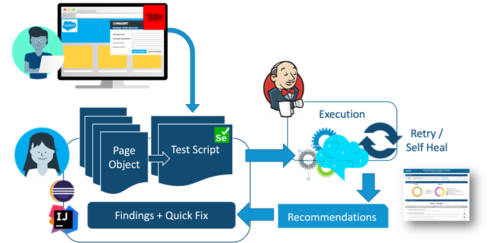
Artificial intelligence is one of the digital marketplace’s most overused buzzwords. The term “AI” conjures up images of Alexa or Siri, computer chess opponents, and self-driving cars.
AI can help humans in a variety of ways, including reducing errors and automating repetitive tasks. Software test automation tools are maturing and have incorporated AI and machine learning (ML) technology. The key point that separates the hype of AI from reality is that AI is not magic, nor the silver bullet promised with every new generation of tools. However, AI and ML do offer impressive enhancements to software testing tools.
More Software, More Releases
Software test automation is increasing in demand just as the worldwide demand for software continues to surge and the demand for developers increases. A recent report by Statista corroborates this expectation with a projection that suggests that the global developer population is expected to increase from 24.5 million in 2020 to 28.7 million by 2024.
Since testing and development resources are finite, there’s a need to make testing more efficient while increasing coverage to do more with the same. Focusing testing on exactly what needs to be validated after each code change is critical to accelerating testing, enabling continuous testing, and meeting delivery goals.
AI and ML play a key role in providing the data needed by test automation tools to focus testing while removing many of the tedious, error-prone, and mundane tasks.
- Improve static analysis adoption.
- Improve unit test creation.
- Reduce test maintenance.
- Reduce test execution.
- Increase API test automation.
- Improve UI test automation.
Real examples
Let’s look at some real-life examples of what happens when you apply AI and ML technology to software testing.
Improve Unit Testing Coverage and Efficiency
Creating unit tests is a difficult task since it can be time-consuming to create unique tests that fully test a unit. One way to alleviate this is by making it easier to create stubs and mocks with assisted test creation for better isolation of the code under test. AI can assist in analyzing the unit under test to determine its dependencies on other classes. Then suggest mocking them to create more isolated tests.
The capabilities of AI in producing tests from code are impressive. However, it’s up to the developers to continuously invest in and build their own tests. Again, using AI test creation assistance, developers can:
- Extend code coverage through clones and mutations.
- Create the mocks.
- Auto-generate assertions
Improve API Testing
The struggle to improve API testing has traditionally relied on the expertise and motivation of the development team because APIs are often outside the realm of QA. Moreover, APIs are sometimes poorly documented. Creating tests for them is difficult and time-consuming.
When it comes to API testing, AI and ML aim to accomplish the following:
- Increase functional coverage with API and service layer testing.
- Make it easier to automate and quicker to execute.
- Reuse the results for load and performance testing.
This technology creates API tests by analyzing the traffic observed and recorded during manual UI tests. It then creates a series of API calls that are collected into scenarios and represent the underlying interface calls made during the UI flow. An ML algorithm is used to study interactions between different API resources and store those interactions as templates in a proprietary data structure. The goal of AI here is to create more advanced parameterized tests, not just repeat what the user was doing, as you get with simple record-and-playback testing.
Automate UI Testing Efficiently
Validating the application’s functionality with UI testing is another critical component of your testing strategy. The Selenium UI test automation framework is widely adopted for UI testing, but users still struggle with the common Selenium testing challenges of maintainability and stability.
AI helps by providing self-healing capabilities during runtime execution to address the common maintainability problems associated with UI testing. AI can learn about internal data structures during the regular execution of Selenium tests by monitoring each test run and capturing detailed information about the web UI content of the application under test. This opens the possibility of self-healing of tests, which is a critical time-saver in cases when UI elements of web pages are moved or modified, causing tests to fail.
Remove Redundant Work With Smart Test Execution
Test impact analysis (TIA) assesses the impact of changes made to production code. The analysis and test selection are available to optimize the execution of unit tests, API tests, and Selenium web UI tests.
To prioritize test activities, a correlation from tests to business requirements is required. However, more is required since it’s unclear how recent changes have impacted the code. To optimize test execution, it’s necessary to understand the code that each test covers and then determine the code that has changed. Test impact analysis allows testers to focus only on the tests that validate the changes.
Benefits of AI/ML in Software Testing
AI and ML provide benefits throughout the SDLC and among the various tools that assist at each of these levels. Most importantly, these new technologies amplify the effectiveness of tools by first and foremost delivering better quality software and helping testing be more efficient and productive while reducing cost and risk.
For development managers, achieving production schedules becomes a reality with no late- cycle defects crippling release timetables. For developers, integrating test automation into their workflow is seamless with automated test creation, assisted test modification, and self-healing application testing. Testers and QA get quick feedback on test execution, so they can be more strategic about where to prioritize testing resources.






